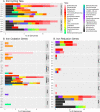Iron-Fueled Life in the Continental Subsurface: Deep Mine Microbial Observatory, South Dakota, USA
- PMID: 34378953
- PMCID: PMC8478452
- DOI: 10.1128/AEM.00832-21
Iron-Fueled Life in the Continental Subsurface: Deep Mine Microbial Observatory, South Dakota, USA
Abstract
Iron-bearing minerals are key components of the Earth's crust and potentially critical energy sources for subsurface microbial life. The Deep Mine Microbial Observatory (DeMMO) is situated in a range of iron-rich lithologies, and fracture fluids here reach concentrations as high as 8.84 mg/liter. Iron cycling is likely an important process, given the high concentrations of iron in fracture fluids and detection of putative iron-cycling taxa via marker gene surveys. However, a previous metagenomic survey detected no iron cycling potential at two DeMMO localities. Here, we revisited the potential for iron cycling at DeMMO using a new metagenomic data set including all DeMMO sites and FeGenie, a new annotation pipeline that is optimized for the detection of iron cycling genes. We annotated functional genes from whole metagenomic assemblies and metagenome-assembled genomes and characterized putative iron cycling pathways and taxa in the context of local geochemical conditions and available metabolic energy estimated from thermodynamic models. We reannotated previous metagenomic data, revealing iron cycling potential that was previously missed. Across both metagenomic data sets, we found that not only is there genetic potential for iron cycling at DeMMO, but also, iron is likely an important source of energy across the system. In response to the dramatic differences we observed between annotation approaches, we recommend the use of optimized pipelines where the detection of iron cycling genes is a major goal. IMPORTANCE We investigated iron cycling potential among microbial communities inhabiting iron-rich fracture fluids to a depth of 1.5 km in the continental crust. A previous study found no iron cycling potential in the communities despite the iron-rich nature of the system. A new tool for detecting iron cycling genes was recently published, which we used on a new data set. We combined this with a number of other approaches to get a holistic view of metabolic strategies across the communities, revealing iron cycling to be an important process here. In addition, we used the tool on the data from the previous study, revealing previously missed iron cycling potential. Iron is common in continental crust; thus, our findings are likely not unique to our study site. Our new view of important metabolic strategies underscores the importance of choosing optimized tools for detecting the potential for metabolisms like iron cycling that may otherwise be missed.
Keywords: DeMMO; FeGenie; continental subsurface; deep subsurface; iron cycling.
Figures





References
-
- Wedepohl KH. 1995. The composition of the continental crust. Geochim Cosmochim Acta 59:1217–1232. 10.1016/0016-7037(95)00038-2. - DOI
-
- Osburn MR, Kruger B, Masterson AL, Casar CP, Amend JP. 2019. Establishment of the Deep Mine Microbial Observatory (DeMMO), South Dakota, USA, a geochemically stable portal into the deep subsurface. Front Earth Sci 7:00196. 10.3389/feart.2019.00196. - DOI
-
- Amend JP, Teske A. 2005. Expanding frontiers in deep subsurface microbiology. Palaeogeogr Palaeoclimatol Palaeoecol 219:131–155. 10.1016/j.palaeo.2004.10.018. - DOI
-
- Bochet O, Bethencourt L, Dufresne A, Farasin J, Pédrot M, Labasque T, Chatton E, Lavenant N, Petton C, Abbott BW, Aquilina L, Le Borgne T. 2020. Iron-oxidizer hotspots formed by intermittent oxic–anoxic fluid mixing in fractured rocks. Nat Geosci 13:149–155. 10.1038/s41561-019-0509-1. - DOI
Publication types
MeSH terms
Substances
Grants and funding
LinkOut - more resources
Full Text Sources
Medical

